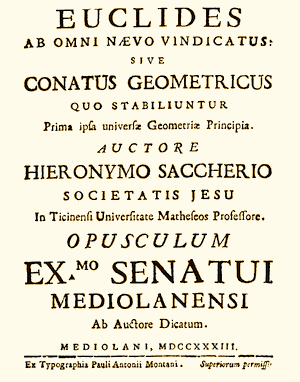| HPS 0410 | Einstein for Everyone |
Back to main course page
John
D. Norton
Department of History and Philosophy of Science
University of Pittsburgh
| The geometry of Euclid's Elements
is based on five postulates. They assert what may be constructed in
geometry. Before we look at the troublesome fifth postulate, we
shall review the first four postulates. They are straightforward. The first postulate is: |
For a compact summary of these and other postulates, see Euclid's Postulates and Some Non-Euclidean Alternatives |
1. To draw a straight line from any point to any point.
This postulates simple says that if you have any two points--A and B, say--then you can always connect them with a straight line.
It is tempting to think that there is no real content in this assertion. That is not so. This postulate is telling us a lot of important material about space. Any two points in space can be connected; so space does not divide into unconnected parts. And there are no holes in space such as might obstruct efforts to connect two points.
The second postulate is:
2. To produce a finite straight line continuously in a straight line.
It tells us that we can always make a line segment longer. That means that we never run out of space; that is, space is infinite.
The third postulate is:
3. To describe a circle with any center and distance.
It allows for the existence of circles of any size and center--say center A and radius AB.
Note that this sort of postulate is not superfluous. A definition can tell us what a circle is, so we know one if ever we find one. But the definition does not assert their existence. Analogously, we can give a definition of a unicorn; that doesn't mean they exist. This postulate says circles exist, just as the first two postulates allow for the existence of straight lines.
The fourth postulate says:
4. That all right angles are equal to one another.
| It just says that whenever we create a right angle by erecting perpendiculars, the angles so created are always the same. | Definition 10. When a straight line standing on another straight line, makes the adjacent angles equal to one another, each of the angles is called a right angle; and the straight line which stands on the other is called perpendicular to it. |
Sameness here means that were we to manipulate the angles by turning and sliding them over the page, they would coincide.
| It may seem that a postulate like this is superfluous. Isn't it completely obvious that all right angles made this way are the same? Yes it is--but that is the essence of the postulates, to assert what is so unproblematic as to make them unchallengeable. Nonetheless, the equality of all right angles still does need to be asserted, since it will be assumed throughout everything that is to follow in Euclid's Elements. | Could it really fail? Yes. The size of a right angle is the arc of a circle it subtends divided by the radius in a neighborhood close to the point. The postulate depends upon the ratio of the circumference of the circle enclosing the point to the radius being the same everywhere in the limit of arbitrarily small circles. While this sameness obtains in all the geometries we are about to look at, once it is stated this simply, one can see that in principle it could fail. In one part of space, the ratio might be the familiar 2π; in other parts, it may be more or less. |
So far everything is going very well. The postulates we have seen are utterly innocuous and readily accepted. But once they are accepted, a lot follows. The simplest is the existence of equilateral triangles. Their construction is the burden of the first proposition of Book 1 of the thirteen books of Euclid's Elements.
The problem is to draw an equilateral triangle on a given straight line AB.
Postulate 3 assures us that we can draw a circle with center A and radius B. Analogously, Postulate 3 also assures us that we can draw a circle with center B and radius BA.
| Now consider both circles together. They intersect at some point. Let us call it C. | The assumption that they meet is not guaranteed by Euclid's postulates. It is an additional assumption that tacitly presupposes that the surface is an ordinary two dimensional surface. This is one of several well known points in Euclid's system where the deductions are less rigorous than we would expect. |
Now connect A and C with a straight line; and B and C with a straight line. That each straight line can be drawn is asserted by Postulate 1.
| Consider the triangle ABC. From the Definitions
15 and 16 of a circle, we know that the two radii AB and AC
of the circle centered at A are equal. AB=AC Similarly, we know that the two radii AB and CB of the circle
centered at B are equal. AB=CB So, by Axiom 1, we know that all three are equal AB=AC=BC and the triangle is equilateral. QED |
Definition 15. A circle is a plane
figure contained by one line, which is called the circumference, and
is such that all straight lines drawn from a certain point within
the figure to the circumference are equal to one another; Definition 16. And this point is called the center of the circle. Axiom 1. Things that are equal to the same thing are equal to one another. QED = quod erat demonstrandum = "which was to be proved" |
This illustrates the power of Euclid's system. Every step is guaranteed by an axiom or a postulate, so that one cannot accept the axioms and postulates without also accepting the proposition.
So far everything has been going very well. However these first four postulates are not enough to do the geometry Euclid knew. Something extra was needed. Euclid settled upon the following as his fifth and final postulate:
5. That, if a straight
line falling on two straight lines make the interior angles on the same
side less than two right angles,
the two straight lines, if produced indefinitely, meet on that side on
which are the angles less than the two right angles.
It is very clear that there is something quite different about this fifth postulate. The first four were simple assertions that few would be inclined to doubt. Far from being instantly self-evident, the fifth postulate was even hard to read and understand.
5. That, if a straight line falling on two straight lines...
... make the interior angles on the same side less than two right angles... [in this case, side on the right]
...the two straight lines, if produced indefinitely, meet on that side on which are the angles less than the two right angles.
Or, in an animation:

From antiquity, there had been discomfort with this fifth postulate, an odd man out among the postulates. The obvious remedy was to find a way to deduce the fifth postulate from the other four. If that could be done, then the fifth postulate would become a theorem and the awkwardness of needing to postulate it would evaporate.
Many tried. The famous astronomer Ptolemy of the first century AD tried. The great mathematician John Wallis tried in the 17th century. The most famous of all attempts was published by Girolamo Saccheri in 1733, Euclides ab Omni Naevo Vindicatus, ("Euclid Cleared of Every Defect”). Yet even this massive work did not achieve its goal, so the efforts continued.

The eighteenth century closed with Euclid's geometry justly celebrated as one of the great achievements of human thought. The awkwardness of the fifth postulate remained a blemish in a work that, otherwise, was of immortal perfection. We knew the geometry of space with certainty and Euclid had revealed it to us.
Copyright John D. Norton. December 28,
2006, February 28, 2007; February 2, 9, 14, September 22, 2008; February
2, 2010; January 1, 2013. January 31, 2022.